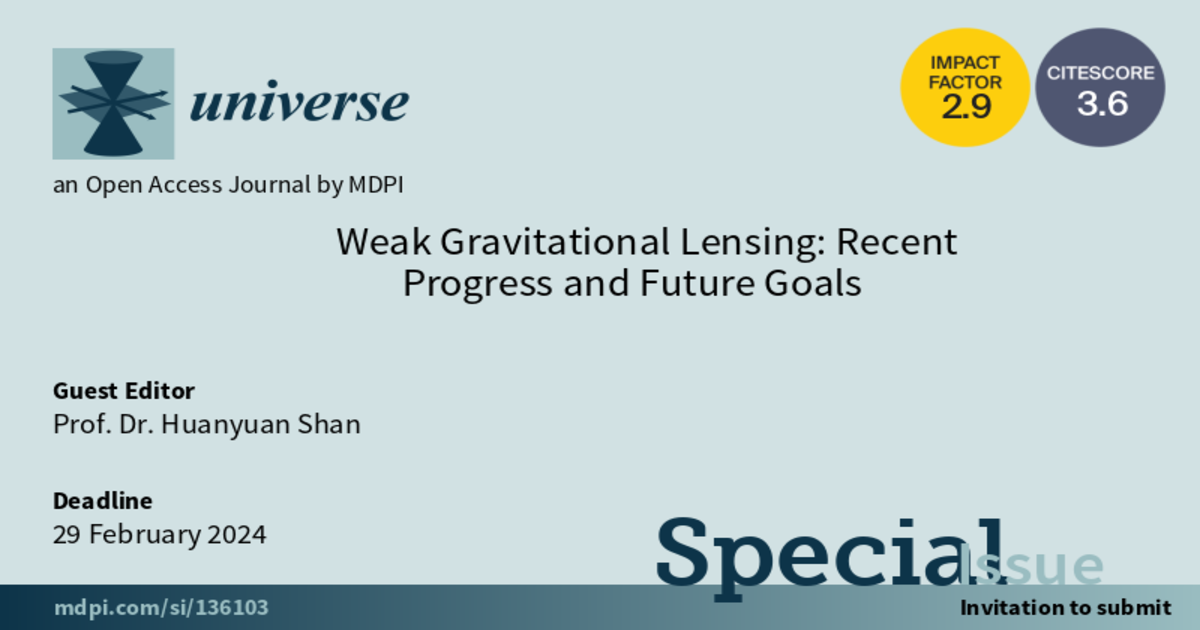Weak Gravitational Lensing: Recent Progress and Future Goals
A special issue of Universe (ISSN 2218-1997). This special issue belongs to the section "Cosmology".
Deadline for manuscript submissions: closed (29 February 2024) | Viewed by 817

Special Issue Editor
Special Issue Information
Dear Colleagues,
Arising from the deflection of light by the gravitational potential of large-scale structures (LSSs) in the universe, weak gravitational lensing has been identified as one of the most promising cosmological probes, especially for understanding the nature of dark matter, dark energy, and the law of gravity. Because weak lensing can only lead to tiny distortions on the shapes, sizes and fluxes of background objects, it is extremely challenging to extract weak lensing signals from observations.
Since the first detections of cosmic shear from LSSs around the beginning of this century, weak lensing studies have rapidly developed and become an important field of research in modern cosmology. Over the past few decades, Stage III surveys, including the Dark Energy Survey (DES), the Kilo Degree Survey (KiDS), and the Hyper Suprime Cam survey (HSC), are attaining their final release of data. Meanwhile, Stage IV surveys will be carried out within the next decade, including the Legacy Survey of Space and Time (LSST), the Euclid mission, the Roman mission, and the Chinese Space Station Telescope (CSST).
This Special Issue will focus on the recent progress and future goals of current and next-generation weak lensing surveys, aimed at presenting essential improvements addressing open questions in the area of weak lensing research. Contributions on various topics are welcome, including developing new weak lensing shear measurement methods, understanding the measurement and astrophysical systematics, and extracting cosmological information with different statistical tools.
Prof. Dr. Huanyuan Shan
Guest Editor
Manuscript Submission Information
Manuscripts should be submitted online at www.mdpi.com by registering and logging in to this website. Once you are registered, click here to go to the submission form. Manuscripts can be submitted until the deadline. All submissions that pass pre-check are peer-reviewed. Accepted papers will be published continuously in the journal (as soon as accepted) and will be listed together on the special issue website. Research articles, review articles as well as short communications are invited. For planned papers, a title and short abstract (about 100 words) can be sent to the Editorial Office for announcement on this website.
Submitted manuscripts should not have been published previously, nor be under consideration for publication elsewhere (except conference proceedings papers). All manuscripts are thoroughly refereed through a single-blind peer-review process. A guide for authors and other relevant information for submission of manuscripts is available on the Instructions for Authors page. Universe is an international peer-reviewed open access monthly journal published by MDPI.
Please visit the Instructions for Authors page before submitting a manuscript. Submitted papers should be well formatted and use good English. Authors may use MDPI's English editing service prior to publication or during author revisions.
Keywords
- weak gravitational lensing
- cosmic shear
- galaxy-galaxy lensing
- magnification
- shear measurement
- redshift calibration
- intrinsic alignment
- baryonic feedback
Benefits of Publishing in a Special Issue
- Ease of navigation: Grouping papers by topic helps scholars navigate broad scope journals more efficiently.
- Greater discoverability: Special Issues support the reach and impact of scientific research. Articles in Special Issues are more discoverable and cited more frequently.
- Expansion of research network: Special Issues facilitate connections among authors, fostering scientific collaborations.
- External promotion: Articles in Special Issues are often promoted through the journal's social media, increasing their visibility.
- e-Book format: Special Issues with more than 10 articles can be published as dedicated e-books, ensuring wide and rapid dissemination.
Further information on MDPI's Special Issue policies can be found here.





